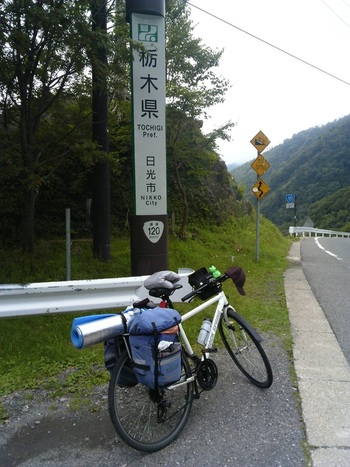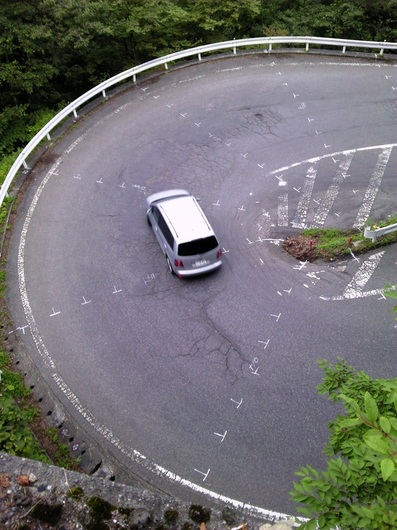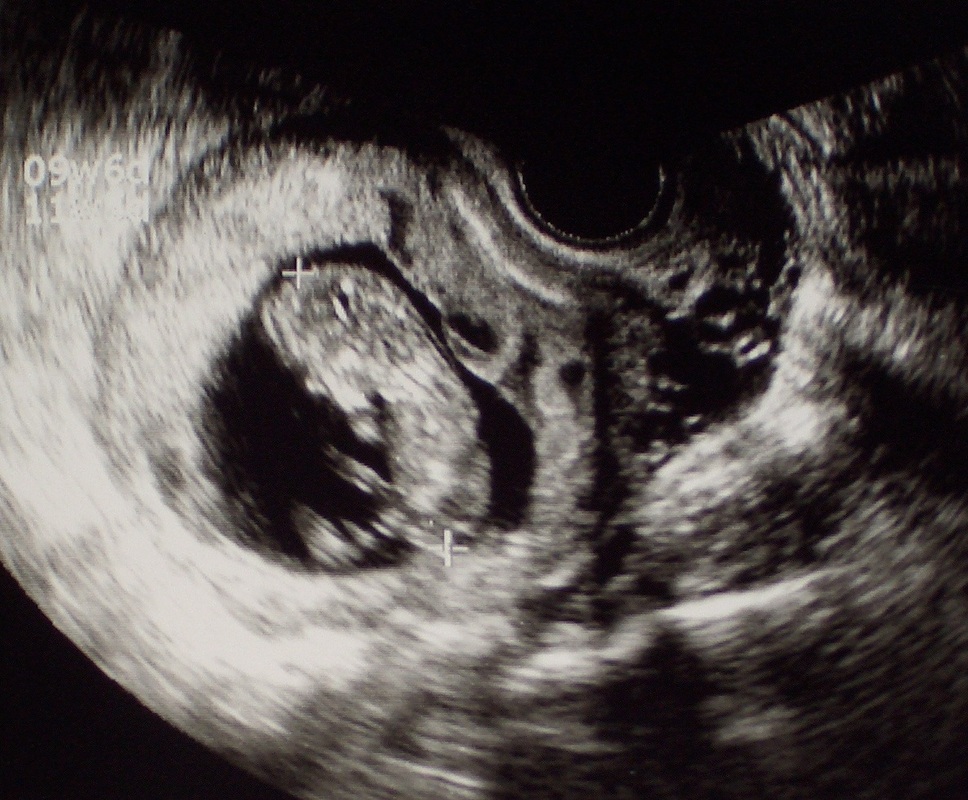As I was passing through the outskirts of Numata City, Mrs M called to ask if I wanted her to come and pick me up.
‘I’ve got to work tomorrow,’ she said, ‘but I could drive to Nikko today and we could put your bicycle in the back of the car.’
I have to say that for a moment or two I was tempted by the offer, but male pride can be a powerful thing. If I accepted, I would officially have failed in my mission to get to Sado and back by pedal power, something I would probably have to lie about if anyone asked me how my summer holidays had gone. So I told Mrs M not to worry, crossed my fingers and carried on towards the Shiisaka Pass as planned.
About halfway there, a truck driver honked his horn, waved and smiled a cheery ‘Hello!’ in a manner that seemed to say, ‘What the bloody hell are you doing trying to ride a bicycle up this hill, you fool!’ and as if to emphasise his point, the next car to pass by was a hearse. I made it to the top unscathed, though, and after a quick freewheel into the Katashina River valley, it was time for today’s main event, namely the forty-kilometre trek to the Konsei Pass.
The lower slopes were comparatively gentle, and on the way I met Ishii-san, the first proper touring cyclist I had seen on the trip. A university student, Ishii-san was wending his way back from Hokkaido (where during the summer holidays you will encounter a touring cyclist approximately once every five minutes) to Nagoya, and nojuku-ing along the way.
‘To be honest,’ I said, ‘I’m still a bit wary of nojuku.’
‘I was too at first, but you get used to it after a week or two.’
‘Did you come over the Konsei Pass from Nikko?’
‘No, but I’m heading for this place.’ Leafing through his copy of the Kanto Mapple, Ishii-san pointed out the Shibu Pass in Nagano Prefecture, which at 2172 metres is the highest in the country. His bicycle appeared to be a good deal heavier than mine, laden as it was with panniers on both the front and back wheels, and – among other things – a full-size non-stick saucepan with a Pyrex lid, so if he could make it to 2172 metres, there was no excuse for me fail at 1880.
As well as its official title of ‘Japan Romantic Road’, Route 120 is known colloquially as ‘Tohmorokoshi (Corn On The Cob) Road’, so that was what I had for elevensies, at one of the many roadside stalls in Katashina Village.
‘Come in, sit down, take a break!’ said a friendly old woman in a patterned pinny and headscarf, before handing me some tohmorokoshi that almost surpassed the aburagé I had in Tochio as the most delicious food of the trip. When I was a child, my mum used to boil corn on the cob for about half an hour and smother it in butter, salt and pepper, whereas this, the stallholder told me, had been barbecued for just three minutes. It was soft, sweet and didn’t need anything to accompany it, although she still insisted on including green tea, pickled cucumber and fresh tomatoes in the 300-yen asking price.
From there onwards, Corn On The Cob Road became steeper and steeper, and just to make things that little bit more agonising, a succession of road signs counted down the distance to the pass in 250-metre increments. Depending on how you translate it, the expression hiza ga warau (膝が笑う) means ‘knees are smiling’ or ‘knees are laughing’, and describes the physical sensation of hiking up a mountain. But it can just as easily be applied to cycling up one, and my knees were laughing so much that by about lunchtime it felt as if they had watched the complete works of the Marx Brothers back-to-back.
I stopped for an extended break at the Marunuma Kogen ski resort, where despite the lack of snow, the lifts were still running and skiers and snowboarders were making use of a stretch of all-weather astro-turf. At the entrance to the resort there was a cast-iron hand pump dispensing natural spring water, and as I was filling my water bottle, a family got out of their car and waited in line behind me. When I turned round, the grandfather broke out into a smile, pointed and exclaimed, ‘Steve McQueen!’
‘Pardon?’ I said.
‘Steve McQueen! What was that film again? Ah yes, Die Hard!’
‘Die Hard?’
‘Yes, Die Hard! Steve McQueen!’
‘No, no,’ I corrected him. ‘ Steve McQueen was in The Great Escape. You must be thinking of Bruce Willis.’
As a white man with a receding hairline, I am often likened to Bruce Willis (who is currently starring in this commercial for Daihatsu), even though a receding hairline is pretty much the only feature we have in common.
‘Bruce Willis?’ The grandfather looked confused, and after turning the thought over in his mind for a moment or two, he smiled and pointed at me again.
‘Steve McQueen!’
Just as I was about to leave around an hour later, another potential Steve McQueen lookalike (and the second proper touring cyclist I had seen on the trip) coasted into the car park. Originally from Canada, J worked for an oil company in Egypt, and while this was his first visit to Japan, he had already taken advantage of his month-on-month-off shift pattern to visit most of the rest of Asia. As well as a Mapple, he carried an iPhone and a solar-powered GPS, and while his bicycle was, like mine, a kind of half-mountain / half-road hybrid, the seat looked as if it had been stolen from one of those old fashioned delivery bikes with a wicker shopping basket on the front.
‘I had some problems with saddle sore and I’ve tried several different seats,’ J explained, ‘but if you ask anyone in the know, they always say to get a leather one. It was expensive but it really does work.’
The break had restored my knees to something like their more sombre selves, and I made it to the pass just before three o’clock, where at the other end of a short tunnel there was a sign telling me I had entered Tochigi, my fifth prefecture of the trip. It was decidedly cool at this altitude, and as I changed into my waterproofs ready for the descent, one or two hikers were emerging from the mist, presumably on their way back from climbing Mount Shirané, whose summit was another seven hundred metres above us.

As well as mountains, marshland and dense, natural forests, the Nikko National Park encompasses a succession of rivers, rapids, lakes and waterfalls, the final one being the 97-metre Kegon waterfall.

From here, Nikko City itself lies at the bottom of the Irohazaka (いろは坂), two one-way roads that between them have forty-eight hairpin bends. Each curve on the Irohazaka is named after a letter from an older version of one of the Japanese alphabets – hence the name ‘iroha’, which means ‘ABCs’ – so in amongst the usual characters, you will find the now obsolete ゐ and ゑ (which are pronounced wi and wé respectively).
The Irohazaka was quite the most enjoyable downhill ride I had ever experienced – if they haven’t already, the people from Top Gear really should do some filming there – and by the end of it the Rock Spring’s brake blocks had worn down by another few fractions of a millimetre, its wheel rims were almost too hot to touch, and together we had clocked 56.7kph, a new fastest speed for the trip (eat that, Clarkson!).

Covering the fifty kilometres between Numata and the Konsei Pass – mostly uphill – had taken me the best part of seven hours, while the fifty kilometres or so between the pass and Nikko – mostly downhill – had taken less than three. It was almost dark when I arrived at Daiya River Park, which as well as a campsite has an athletics track, a bird sanctuary, a farm, a mini golf course, classrooms and a concert stage, although tonight I was practically the only person there.
‘Do you get many mosquitoes?’ I asked the receptionist as he was showing me to the campground.
‘Not really,’ he said, ‘although you should watch out for abu.’
‘What are they?’
‘They’re sort of a cross between a mosquito and a bee.’
‘And do they bite?’
‘Oh yes, although it’s not itchy like a mosquito bite.’
‘No?’
‘No. It’s just painful.’
‘Right. Er, thanks for warning me.’
There wasn’t much light to see by in this secluded corner of the park, so I changed out of my cycling gear beneath one of the street lights that lined the footpath. Just as I was putting my shoes back on, a jogger emerged from the shadows, and while I bid her good evening in as friendly a way as I could muster, stumbling across a scruffy looking foreigner on a dark evening had probably given her the fright of her life, and she didn’t say anything back. Thank goodness she hadn’t run past when I was halfway out of my shorts, or I could have ended up spending the night in a police cell instead of the Snow Peak.




